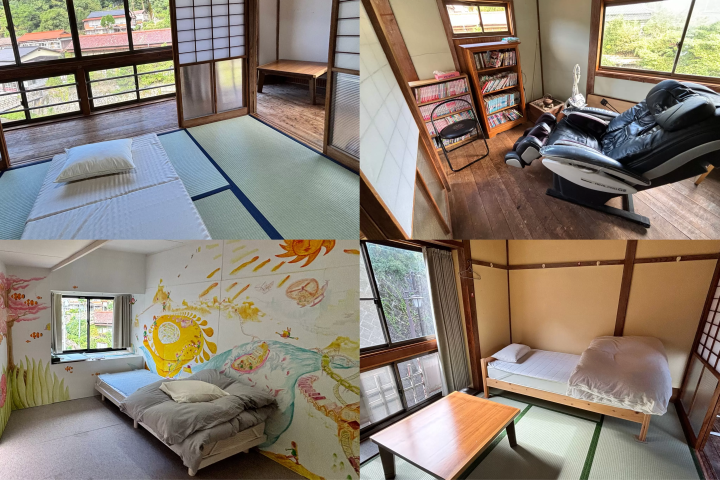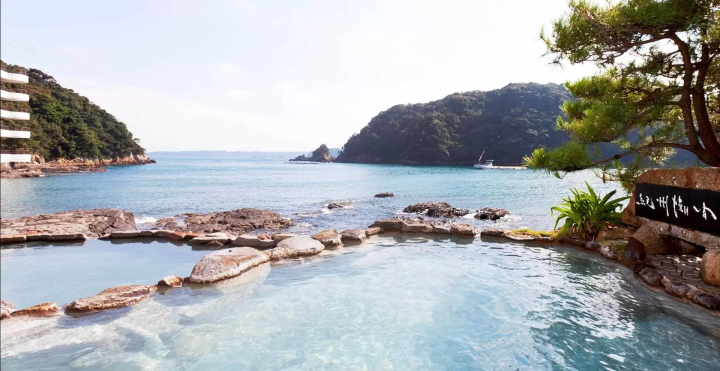Direct Bus from Hakata! Top Ryokan & Local Cuisine in Tawarayama Onsen – Experience Authentic Japanese Hot Springs

Tucked away in the quiet mountains of Yamaguchi Prefecture, Tawarayama Onsen is a nationally recognized hot spring area where Japan’s traditional toji (healing retreat) culture still thrives. This article introduces the best ryokan, local hot springs, and gourmet experiences that heal both body and soul. Perfect for those seeking an authentic Japanese onsen experience — just a direct bus ride from Hakata!
-
Table of Contents
- What is Tawarayama Onsen?
- Recommended hot spring facilities in Tawarayama Onsen
- Recommended gourmet spots in Tawarayama Onsen
- If you want to fully enjoy Tawarayama Onsen, we recommend staying at "Guesthouse Neruyama"
- Access to Tawarayama Onsen
Please also read this article for more information on Tawarayama Onsen's gourmet food and surrounding tourist attractions.
What is Tawarayama Onsen?
History and Features of Tawarayama Onsen

Tawarayama Onsen has a history of about 1100 years. It is known as the hot spring where the white monkey, a symbol of the region, healed his wounds, and the sacredness and medicinal properties of the hot spring have been passed down since ancient times.
This episode also shows that Tawarayama Onsen has developed into a place for "touji" (hot spring therapy).

The spring quality is alkaline and simple, and is characterized by its clear, colorless, soft water. It is especially gentle on the skin and has a relaxing effect, earning it a reputation as a "beautiful skin bath." Its excellent spring quality has led to it being designated as a national health resort . The hot springs are also effective in treating neuralgia, muscle pain, and fatigue, and the "hot spring therapy culture" of thoroughly healing the entire body is still treasured today.
Recommended hot spring facilities in Tawarayama Onsen
Introduction to outdoor bath culture
Most of the accommodations at Tawarayama Onsen do not have indoor baths, but instead use the two public baths in the center of the hot spring town, "Machi no Yu" and "Hakuen no Yu," as outdoor baths. These two hot springs use different spring sources and are said to have different effects.
Machi no Yu
"Machi no Yu" is a free-flowing hot spring on the premises. It is popular with local residents, and many of them use it like a public bath.
The excellent spring water is said to be particularly effective for easing neuralgia, muscle pain, and joint pain, making it ideal for those who want to slowly soothe their daily fatigue.

The warm water is 41 degrees, so it's tempting to soak in it for a long time, but the hot spring ingredients are so strong that if you stay in it for more than 15 minutes you can get sick. (The ingredients in the hot spring can affect the body and cause ailments such as headaches, dizziness, and nausea) So locals repeatedly warn you to be careful.

There is also a drinking fountain within the facility where you can drink the spring water for free. Two-liter plastic bottles are sold for 300 yen, and many people buy them not only to drink, but also to make coffee or cook rice.

The bathing fee is relatively reasonable, making it a convenient place to visit for a day trip. Tickets can only be purchased in cash, so don't forget to bring coins! Another great thing about this bath is that it's open from 6:00am to 10:00pm.
Hakuen no Yu

"Hakuen no Yu" is one of the outdoor baths alongside the Machi no Yu, and its name comes from a white monkey that appears in legend. At this hot spring, you can enjoy a "mixed spring" that blends two hot springs, as well as a bathtub with free-flowing hot spring water from the "Kawa no Yu" hot spring.
The water used at Hakuen no Yu is particularly gentle on the skin, and is effective not only for beautifying the skin, but also for treating atopic dermatitis and burns. Local residents have long used different hot springs depending on their physical condition and the part of the body they want to improve. By enjoying the different spring qualities, you can warm your body thoroughly and heal your whole body.

The bathtub and washing area are spacious, and the open-air bath surrounded by rocks is one of its attractions. In addition to a shop, the first floor also has a foot bath that can be used for free and a "pet bath" for pets. This hot spring is closed on Tuesdays, Wednesdays, and Thursdays (subject to change), so it is recommended to check the opening days in advance.
Recommended gourmet spots in Tawarayama Onsen
After soaking in the hot springs, enjoy some delicious food! While strolling through the hot spring town, you can try the local specialty "Sanzaru Manju" and experience wild game cuisine at the restaurant "Tabeyama."
Fukuda Sengetsudo: Sanzaru Manju

The "Three Monkeys Manju" is a hand-baked Japanese sweet inspired by the legend of the "White Monkey", a symbol of Tawarayama Onsen, and features a fluffy castella dough and bean paste. It is a traditional sweet that is hand-baked every morning by the third-generation owner! Taking a photo with the cute monkey in hand is sure to become a good memory of your trip.

Freshly baked Manju is especially delicious! If you come at the right time, you might be able to buy some freshly baked one.
Soba Izakaya: Tabeyama
At the soba izakaya "Tabeyama" next to Machi no Yu, you can enjoy hand-made soba noodles, a local specialty, as well as wild game dishes made with deer and wild boar from Tawarayama. The seasonal special menu, made with locally harvested vegetables and fruits, is also appealing!

On this day, I ordered "chestnut rice" made with freshly harvested chestnuts, and soba noodles and sour drinks made with "Nagato Yuzukichi," an original citrus fruit grown in Yamaguchi Prefecture! The mellow acidity and plenty of juice make for an addictive taste. This is a local specialty that can be found around September and October.

In the evening, you can enjoy rare Japanese sake and a selection of alcoholic drinks collected by the owner, who is a fan of Italian wine. They go perfectly with game dishes made with deer and wild boar.
If you want to fully enjoy Tawarayama Onsen, we recommend staying at "Guesthouse Neruyama"
This time I stayed at "Guesthouse Neruyama." It is a very reasonable inn that only offers accommodation without meals. All the rooms are private. There are various types of rooms, from standard Japanese-style rooms to concept rooms designed by local artists.

There is also a lounge where locals and visitors can mingle, and a guest kitchen with simple facilities, including a refrigerator, rice cooker, coffee maker, and cooking utensils.

■ Dinner
As this is a lodging only, dinner is not provided. You can have dinner at the soba izakaya "Tabeyama" (located opposite the inn). We also recommend buying produce from the farm shop on the first floor of "Hakuen no Yu" or bringing your own produce to cook.
■Breakfast
A Japanese breakfast can be arranged for 700 yen per meal by prior reservation only for guests staying at the hotel on Fridays, Saturdays, and Sundays.

Guests are also offered guided tours around the hot spring town, as well as hands-on programs to learn about the local culture. This allows you to experience not only the hot springs, but also the nature and history of Yamaguchi Prefecture, making for a more fulfilling stay.
Access to Tawarayama Onsen
We recommend accessing Tawarayama Onsen by bus or rental car.
If you take the bus, you will need to transfer several times, so it is important to check the schedule in advance.

If you are traveling by bus from Yamaguchi Ube Airport (same applies if you are traveling by bus from Shin-Yamaguchi Station)
First, take a bus from the airport to Shin-Yamaguchi Station (about 30 minutes).
After arriving at Shin-Yamaguchi Station, take the direct bus from Nagato City to Shin-Yamaguchi Station to Senza Kitchen.
You can board the bus without a reservation if there is availability, but we recommend making a reservation in advance via the web or phone. (The ride takes about 1 hour and 30 minutes.)
To get to Tawarayama Onsen from Senza Kitchen, take the Sanden Bus (approximately 40 minutes) or a taxi (reservation required).
There is only one bus per day, but if it fits your schedule, we recommend the Nagato Sightseeing Taxi. Please note that reservations must be made at least one day in advance and that it is a shared taxi.
If traveling by bus from Yamaguchi Ube Airport (Friday, Saturday, Sunday, Monday)
A direct bus runs from the airport to Senza Kitchen only on Fridays, Saturdays, Sundays and Mondays.
There are only two flights per day, but the fare for adults is 3,500 yen one way. (The ride takes about 1 hour and 30 minutes.)
If you are planning to travel on Friday, Saturday, Sunday or Monday, we recommend using this service.
If you are coming from Fukuoka by bus
There is a direct bus called "Otozurego" (reservation required) that runs from Hakata Station or Fukuoka Tenjin Bus Terminal to Nagato City and Senza Kitchen. It runs once a day (days of operation may vary) and costs 4,000 yen one way and 7,000 yen round trip (available only online).
National hot spring resorts are designated by the Minister of the Environment under the Hot Springs Act as healthy hot spring resorts where the benefits of hot spring use are expected to be sufficient. 79 hot spring resorts have been designated nationwide (as of October 2024). National hot spring resorts are selected based on the following criteria. 1. Conditions regarding the quality and volume of hot spring water (1) The source of the hot spring water used must be a therapeutic spring. (2) The hot spring water used must have an abundant volume of water. The standard volume of water flow must be 0.5 liters per minute or more per hot spring user. 2. Conditions regarding the environment of the hot spring resort (1) The hot spring is suitable as a resort from the perspective of the natural environment, townscape, history, climate, culture, etc. (2) A plan for the placement of doctors who can provide guidance on proper hot spring use and health management from a medical perspective, or a plan for the placement or training policy of personnel who can provide guidance on bathing methods, etc. in cooperation with the doctors, must be established. (3) Appropriate efforts will be made to protect hot spring resources, manage the hygiene of hot springs, promote public use of hot springs, and take into consideration the elderly and disabled, etc. (4) Enhanced efforts to prevent disasters.
The contents on this page may partially contain automatic translation.


![[Yamaguchi hidden gem] 8 Best Things to Do in Tawarayama Onsen – Discover the Charm of This Retro Hot Spring Town](https://resources.matcha-jp.com/resize/200x2000/2024/10/31-206839.webp)






























![[JR KYUSHU HOTEL Blossom Oita] A hotel directly connected to Oita Station - A comprehensive guide to access!](https://resources.matcha-jp.com/resize/720x2000/2025/10/23-247814.webp)

![Deep dive into Japanese brands! A tour of famous leather shoe stores with GENSEI & Nin [Harta Edition]](https://resources.matcha-jp.com/resize/720x2000/2025/12/18-253277.webp)
